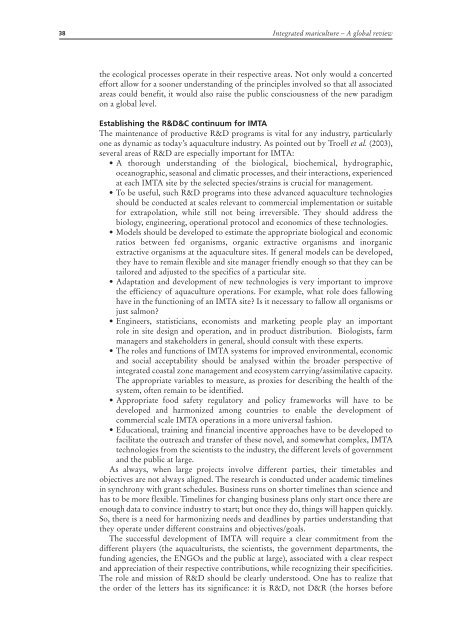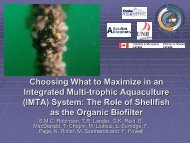Integrated multi-trophic aquaculture (IMTA) in marine temperate waters
Integrated multi-trophic aquaculture (IMTA) in marine temperate waters
Integrated multi-trophic aquaculture (IMTA) in marine temperate waters
Create successful ePaper yourself
Turn your PDF publications into a flip-book with our unique Google optimized e-Paper software.
38<br />
<strong>Integrated</strong> mariculture – A global review<br />
the ecological processes operate <strong>in</strong> their respective areas. Not only would a concerted<br />
effort allow for a sooner understand<strong>in</strong>g of the pr<strong>in</strong>ciples <strong>in</strong>volved so that all associated<br />
areas could benefit, it would also raise the public consciousness of the new paradigm<br />
on a global level.<br />
Establish<strong>in</strong>g the R&D&C cont<strong>in</strong>uum for <strong>IMTA</strong><br />
The ma<strong>in</strong>tenance of productive R&D programs is vital for any <strong>in</strong>dustry, particularly<br />
one as dynamic as today’s <strong>aquaculture</strong> <strong>in</strong>dustry. As po<strong>in</strong>ted out by Troell et al. (2003),<br />
several areas of R&D are especially important for <strong>IMTA</strong>:<br />
• A thorough understand<strong>in</strong>g of the biological, biochemical, hydrographic,<br />
oceanographic, seasonal and climatic processes, and their <strong>in</strong>teractions, experienced<br />
at each <strong>IMTA</strong> site by the selected species/stra<strong>in</strong>s is crucial for management.<br />
• To be useful, such R&D programs <strong>in</strong>to these advanced <strong>aquaculture</strong> technologies<br />
should be conducted at scales relevant to commercial implementation or suitable<br />
for extrapolation, while still not be<strong>in</strong>g irreversible. They should address the<br />
biology, eng<strong>in</strong>eer<strong>in</strong>g, operational protocol and economics of these technologies.<br />
• Models should be developed to estimate the appropriate biological and economic<br />
ratios between fed organisms, organic extractive organisms and <strong>in</strong>organic<br />
extractive organisms at the <strong>aquaculture</strong> sites. If general models can be developed,<br />
they have to rema<strong>in</strong> flexible and site manager friendly enough so that they can be<br />
tailored and adjusted to the specifics of a particular site.<br />
• Adaptation and development of new technologies is very important to improve<br />
the efficiency of <strong>aquaculture</strong> operations. For example, what role does fallow<strong>in</strong>g<br />
have <strong>in</strong> the function<strong>in</strong>g of an <strong>IMTA</strong> site? Is it necessary to fallow all organisms or<br />
just salmon?<br />
• Eng<strong>in</strong>eers, statisticians, economists and market<strong>in</strong>g people play an important<br />
role <strong>in</strong> site design and operation, and <strong>in</strong> product distribution. Biologists, farm<br />
managers and stakeholders <strong>in</strong> general, should consult with these experts.<br />
• The roles and functions of <strong>IMTA</strong> systems for improved environmental, economic<br />
and social acceptability should be analysed with<strong>in</strong> the broader perspective of<br />
<strong>in</strong>tegrated coastal zone management and ecosystem carry<strong>in</strong>g/assimilative capacity.<br />
The appropriate variables to measure, as proxies for describ<strong>in</strong>g the health of the<br />
system, often rema<strong>in</strong> to be identified.<br />
• Appropriate food safety regulatory and policy frameworks will have to be<br />
developed and harmonized among countries to enable the development of<br />
commercial scale <strong>IMTA</strong> operations <strong>in</strong> a more universal fashion.<br />
• Educational, tra<strong>in</strong><strong>in</strong>g and f<strong>in</strong>ancial <strong>in</strong>centive approaches have to be developed to<br />
facilitate the outreach and transfer of these novel, and somewhat complex, <strong>IMTA</strong><br />
technologies from the scientists to the <strong>in</strong>dustry, the different levels of government<br />
and the public at large.<br />
As always, when large projects <strong>in</strong>volve different parties, their timetables and<br />
objectives are not always aligned. The research is conducted under academic timel<strong>in</strong>es<br />
<strong>in</strong> synchrony with grant schedules. Bus<strong>in</strong>ess runs on shorter timel<strong>in</strong>es than science and<br />
has to be more flexible. Timel<strong>in</strong>es for chang<strong>in</strong>g bus<strong>in</strong>ess plans only start once there are<br />
enough data to conv<strong>in</strong>ce <strong>in</strong>dustry to start; but once they do, th<strong>in</strong>gs will happen quickly.<br />
So, there is a need for harmoniz<strong>in</strong>g needs and deadl<strong>in</strong>es by parties understand<strong>in</strong>g that<br />
they operate under different constra<strong>in</strong>s and objectives/goals.<br />
The successful development of <strong>IMTA</strong> will require a clear commitment from the<br />
different players (the aquaculturists, the scientists, the government departments, the<br />
fund<strong>in</strong>g agencies, the ENGOs and the public at large), associated with a clear respect<br />
and appreciation of their respective contributions, while recogniz<strong>in</strong>g their specificities.<br />
The role and mission of R&D should be clearly understood. One has to realize that<br />
the order of the letters has its significance: it is R&D, not D&R (the horses before



